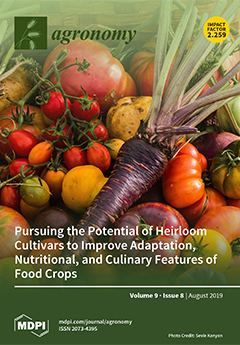Plant-derived protein hydrolysates (PHs) are gaining prominence as biostimulants due to their potential to improve yield and nutritional quality even under suboptimal nutrient regimens. In this study, we investigated the effects of foliar application of a legume-derived PH (0 or 4 mL L
−1) on greenhouse baby spinach (
Spinacia oleracea L.) under four nitrogen (N) fertilization levels (0, 15, 30, or 45 kg ha
−1) by evaluating morphological and colorimetric parameters, mineral composition, carbohydrates, proteins, and amino acids. The fresh yield in untreated and biostimulant-treated spinach plants increased in response to an increase in N fertilization from 1 up to 30 kg ha
−1, reaching a plateau thereafter indicating the luxury consumption of N at 45 kg ha
−1. Increasing N fertilization rate, independently of PH, lead to a significant increase of all amino acids with the exception of alanine, GABA, leucine, lysine, methionine, and ornithine but decreased the polyphenols content. Interestingly, the fresh yield at 0 and 15 kg ha
−1 was clearly greater in PH-treated plants compared to untreated plants by 33.3% and 24.9%, respectively. This was associated with the presence in of amino acids and small peptides PH ‘Trainer
®’, which act as signaling molecules eliciting auxin- and/or gibberellin-like activities on both leaves and roots and thus inducing a “nutrient acquisition response” that enhances nutrients acquisition and assimilation (high P, Ca, and Mg accumulation) as well as an increase in the photochemical efficiency and activity of photosystem II (higher SPAD index). Foliar applications of the commercial PH decreased the polyphenols content, but on the other hand strongly increased total amino acid content (+45%, +82%, and +59% at 0, 15, and 30 kg ha
−1, respectively) but not at a 45-kg ha
−1-rate. Overall, the use of PH could represent a sustainable tool for boosting yield and nitrogen use efficiency and coping with soil fertility problems under low input regimens.
Full article





